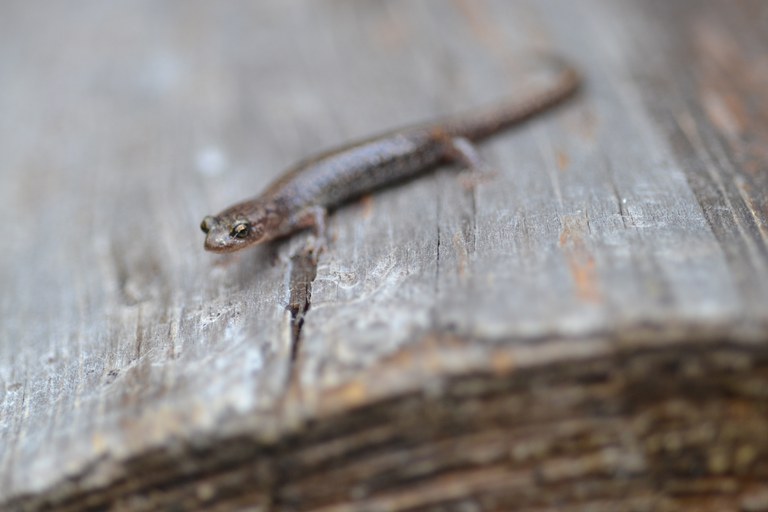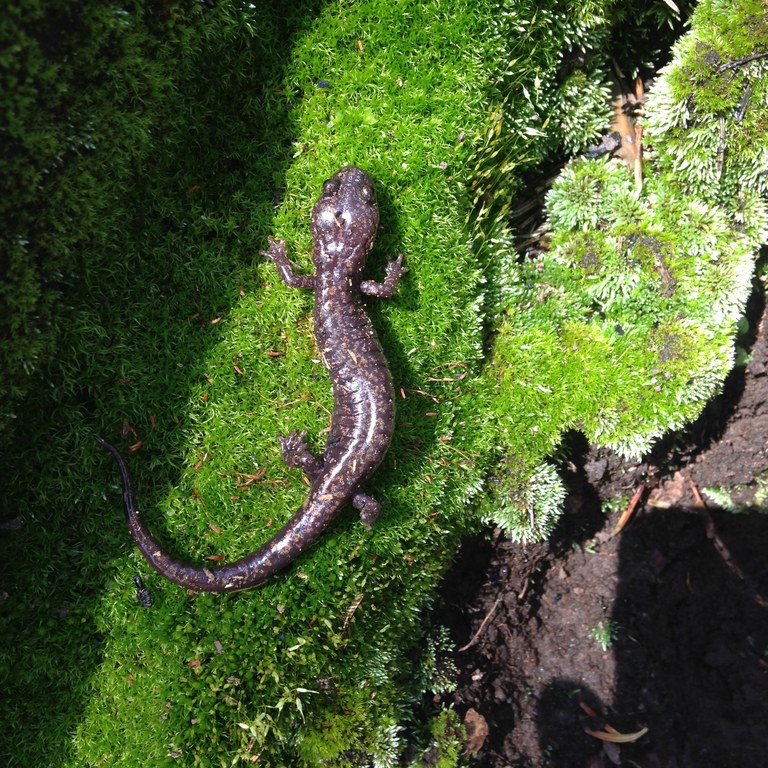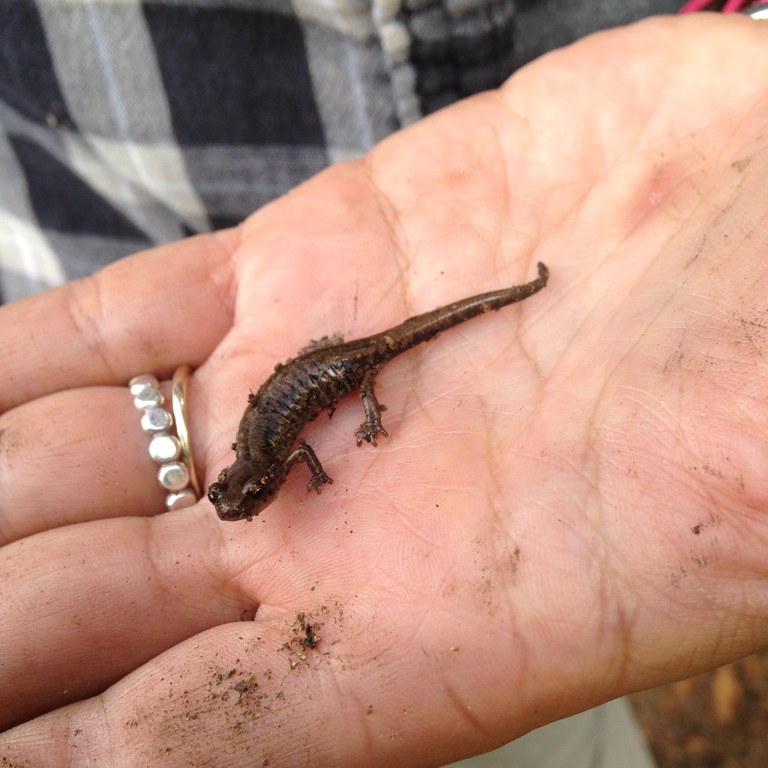Small, brown and magical

Finding a Sacramento Mountain salamander in the wild is somewhat like stumbling upon a unicorn—you have to be in the right place at the right time with the right environmental conditions.
For this reason, ABQ BioPark Zookeeper Clare Steinberg said it’s “magical” to encounter this slightly sun-glittery looking brown salamander in its home turf.
Chances are, most people will probably never encounter this cryptic species in the wild though—those who do will need to be near the top of one of the mountains in its range during the monsoon season and the individual will have just happened to peak underneath one of the salamander’s favorite hiding spots.
The Sacramento Mountain salamander is one of New Mexico’s three salamander species, and one of two that are endemic to the state (the other is the Jemez Mountain salamander). These salamanders face a declining population, and the zoo is part of a special project to help safeguard them.
Threats from all Fronts
The zoo received 24 salamanders from the New Mexico Department of Fish and Game in 2013. Officials discovered and collected the salamanders during a road expansion project at Ski Apache, located in the Ruidoso area of Southern New Mexico.
Although not federally listed as an endangered species, New Mexico considers the salamanders threatened. The species’ main threats are logging and forest fires. In the future, climate change and drought could add to the species’ vulnerability.
“As it gets warmer, they have to get to higher and higher habitats and eventually, if you keep doing that, you’re going to fall of the mountain,” said Steinberg.
A salamander-specific variation of the chytridiomycota (chytrid) fungus called Batrachochytrium salamandrivorans (Bsal) could also spell disaster for these salamanders—its sister strain is currently wreaking havoc on frog and toad populations all over the world. Bsal was born in Asia, and Steinberg said that although this deadly fungus hasn’t made its way to the States, that it’s “pretty much a matter of time.”
Bsal has a 96 percent mortality rate among some European salamanders, so its arrival could devastate the small populations of Sacramento Mountain or Jemez Mountain salamanders.
“With an isolated species like this, it’s very unlikely it would have a lot of immunity to a foreign disease like that,” said Steinberg. “That’s a big reason why it’s a good idea for us to be working with this species in captivity.”
The Sacramento Mountain salamander is somewhat mysterious. No other facility has ever worked with the species, and the ABQ BioPark is making new observations about the salamanders’ behavior. This new data will also help keepers understand similar species like the Jemez Mountain salamander, which faces even higher stakes against extinction.
Drought and forest fires have caused the Jemez species to become extremely threatened and Steinberg said the state is hoping that if the zoo has success with the Sacramento Mountain salamanders, that it could entrust the facility to help with the Jemez species’ cause. A strong Sacramento Mountain salamander program could also mean an eventual wild release and the BioPark could potentially provide individual salamanders to other institutions as part of an official breeding program.
A Challenging Endeavor
“It’s a big challenge we’re really excited about,” said Steinberg.
Steinberg said the biggest barrier in caring for a little-known salamander species is lack of literature on basic behavior and husbandry. The ABQ BioPark is adding to the Sacramento Mountain salamander knowledge base and is also part of a New Mexico based salamander working group that includes several federal and state agencies.
But there are other challenges. For one, the species has a three year breeding cycle, so each new generation comes about very slowly. In the first year, the salamanders mate. Females lay their eggs during the second year. The salamanders take a break during their third year and resume the cycle again in the next.
But the salamanders may live decades, so they have time to spare. One wild Jemez Mountain salamander was aged at 17 years old, according to Steinberg.
The staff paired as many of the salamanders as possible and the amphibian couples have cohabitated for about a year. The BioPark believes that three or four of its females currently carry eggs, which will be fertilized externally when the time is right. Zookeeper Katie Anderson said staff plans to stay as hands off as possible.
“We have them paired up and like to give them their space,” said Anderson.
In addition to a long mating cycle and lack of knowledge on the species, zookeepers struggle with maintaining proper environmental conditions for the salamanders.
In the wild, these cryptic amphibians dwell underneath rotting logs near mountaintops and thrive in a cool, moist climate. At the BioPark, zookeepers keep the salamander room in the 50s and 60s and mist the animals several times a week. Staff also accounts for seasonal weather patterns—during the summer months they increase daylight to mimic longer days and misting frequency to mimic the monsoon.
Steinberg and Anderson admitted that their techniques are “learn as you go” since no one really knows the wintering habits of the species. To gain valuable insight, the zoo has enlisted the help of experts from other facilities who have had success caring for and breeding other salamander species.
“We’re trying to get ideas from people who know salamanders,” said Anderson.
Through one of these collaborations, BioPark zookeepers learned about “Tadpole Tea,” a mix of slightly acidic ingredients that helps prevent mold. As the salamanders begin to breed, this may help the BioPark thwart this common threat to captive salamander egg survival.
The zoo’s Sacramento Mountain salamanders are not on exhibit because they tend to hide under rocks most of the time. Nonetheless, zoo visitors can see a variety of other salamander species, including the tiger salamander, water dogs and the Easter salamander.

Small, brown and magical?
Just because the Sacramento Mountain salamander is brown, small—it measures at about 3 inches from head to the tip of its tail—and apt to hide doesn’t mean it’s dull.
“By description, they’re kind of boring, but they’re interesting at the same time,” said Anderson.
It’s in a genus known colloquially as the “climbing salamander” and from time to time, zookeepers will catch them climbing up the sides of their habitats.
“They’re pretty good at using their little sticky toes,” Steinberg said.
The species is sexually dimorphic, which is very rare in the world of amphibians and reptiles. It’s all in the head width, where males beat out females with some extra musculature—of course, because of little knowledge about the species, the staff isn’t quite sure what the purpose of that extra head width is.
Another cool fact—the salamanders breathe through their skin because they lack proper lungs.
North America boasts the world’s highest diversity of salamander species, but not many of them ended up in New Mexico. Besides the Jemez Mountain and Sacramento Mountain salamanders, only one species—the tiger salamander—resides in the Land of Enchantment.
Steinberg said although New Mexico only has a few salamander species, it is lucky to have two endemic species (endemic species are those that are particular to a specific region).
“They’re these little brown salamanders that manage to live at the top of a mountain in New Mexico,” said Steinberg. “It’s kind of rare to have a species like that in the middle of the desert.”
Story: Tina Deines
Taking Action for Salamanders
There are a number of ways that the average person can help salamanders.
Check out Chopsticks for Salamanders
Logging is a dire threat to many animals, including salamanders. Cutting down trees eliminates essential forest cover, which is essential to retaining moisture in a forest ecosystem. As a result, the ground dries and warms up. Chopsticks for Salamanders gives consumers a conscious choice to purchase reusable metal chopsticks in lieu of wooden ones (many of which are unsustainably sourced from forests, threatening animals like salamanders). Proceeds from these reusable chopsticks go to salamander conservation.
Be a Responsible Pet Owner
Those who are interested in keeping salamanders as pets should research first and avoid buying species that aren’t from North America like Japanese and Chinese newts, which are frequently sold in pet stores. It is now illegal to import salamanders to the U.S., but these captive-bred salamanders can still can carry and spread Bsal. A tiger salamander or an axolotl is a much safer choice. Additionally, salamanders—and other pets—should never be released into the wild.
Share with Wildlife
Those who file a New Mexico income tax can check a box to donate to the NM Department of Fish and Game’s “Share with Wildlife” program. This program helps New Mexico species that don’t receive state funding from other sources, such as salamanders.
Say No to Salamanders as Bait
Salamanders should not be used as fishing bait. The hook causes pain to the animal. Bait salamanders also can spread diseases like Bsal.


